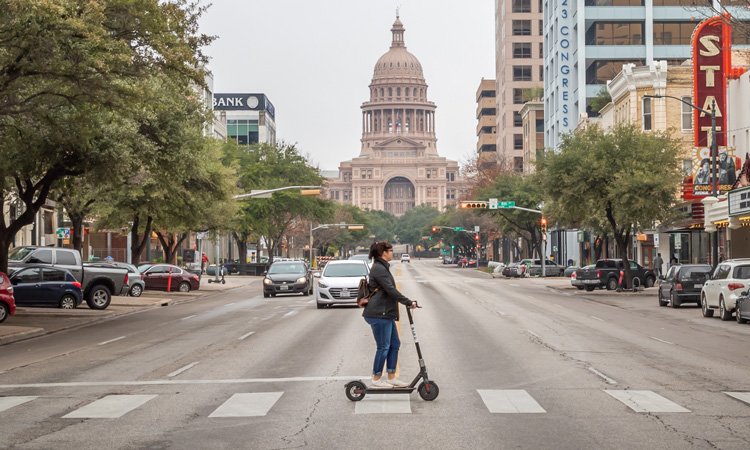How micromobility can support a green economic recovery post-COVID-19
- Like
- Digg
- Del
- Tumblr
- VKontakte
- Buffer
- Love This
- Odnoklassniki
- Meneame
- Blogger
- Amazon
- Yahoo Mail
- Gmail
- AOL
- Newsvine
- HackerNews
- Evernote
- MySpace
- Mail.ru
- Viadeo
- Line
- Comments
- Yummly
- SMS
- Viber
- Telegram
- Subscribe
- Skype
- Facebook Messenger
- Kakao
- LiveJournal
- Yammer
- Edgar
- Fintel
- Mix
- Instapaper
- Copy Link
Posted: 22 June 2020 | Maurice Henderson - Bird | No comments yet
Maurice Henderson, Director of Government Partnerships at micromobility firm Bird, explains how micromobility operators can help cities keep moving during and after the COVID-19 pandemic, and why these services are key to the coming environmentally-friendly economic recovery.


The transition to a post-COVID world is not going to be as simple as offering more micromobility options than before. How can service providers look to fill the void that COVID-19 has created?
While micromobility provides many benefits – such as offering a customisable way to get around while maintaining social distance – I agree the solution does not hinge exclusively on quantity. I think it will depend, in part, on carefully nurturing the day-to-day upkeep of already available vehicles so communities can safely take advantage of the industry’s services. As operations begin to ramp up again, it is crucial for teams to maintain diligent sanitation practices. At Bird, this means laying out clear guidelines for deep cleaning and sanitising our vehicles. Bird technicians and field teams use CDC-approved disinfectant products to thoroughly sanitise each of our vehicles every time they are recharged or serviced for maintenance. Regular spot cleanings are also performed in the field on surfaces such as bells, throttles and handlebars. You can read more on our blog here.
Both operators and local policymakers should define and communicate best practices for how to responsibly utilise these shared, light electric vehicles”
Recently, Bird ramped up operations in Portland, Oregon, which will continue to help minimise urban congestion while keeping commuters safe. In fact, e-scooters are a great option for essential workers who still need to travel between their jobs and their homes, and Bird is offering free rides to healthcare workers and emergency personnel in Portland and other cities right now. Additionally, e-scooters have been a resource to deliver essential goods across communities. Recently in Italy, La Croce Rossa volunteers used donated Bird scooters to deliver food and medical supplies to vulnerable communities.
I also think an important component for the success of the industry is enhanced rider education. Both operators and local policymakers should define and communicate best practices for how to responsibly utilise these shared, light electric vehicles.
Do you think these micromobility transportation modes need to be more integrated with existing infrastructure and transport networks? How can this be achieved?
Yes, and I think it starts with infrastructure. In our ‘Safe Streets Micromobility Roundtable’ discussion last March, most participants agreed that safer and enhanced infrastructure that accommodates vehicles, such as scooters and bikes, is the most significant solution to improve safety for all road users, and thus, ridership overall. Data has proven that investing in protected bike and scooter infrastructure encourages more riders to take to the streets. In Paris, for example, Mayor Anne Hidalgo proposed eliminating 72 per cent of all on-street parking to make way for 100 per cent cyclable streets by 2024. As a result, between 2018 and 2019, the number of Parisians opting to use bikes jumped by 54 per cent. Here in the U.S., Atlanta, Georgia is slated to triple the amount of protected bike infrastructure within two years, and car-free transitways, like Market Street in San Francisco, are shifting the priority away from automobiles to pedestrians and public transit users. These efforts must be achieved in parallel with other safety initiatives and responsible data-sharing practices.
By implementing more accessible pricing programmes and other equity-focused services as well as through the CBO partners, there is a concerted effort to improve the quality of life for the broadest spectrum of people through expanded mobility offerings.”
There’s also a set of policies around integrating micromobility vehicles like e-scooters with public transit that are being adopted. We think of scooters as natural complements to public transit, serving to extend its reach, and provide redundancies as needed; public transit stations can incorporate dedicated corrals and space to accommodate shared modes. Transit authority and micromobility operators can coordinate around vehicle staging to enhance connectivity. We have also seen some initiatives around data-sharing that can be considered to enhance interconnections and the utilisation of services in combination.
Micromobility companies have been working to formalise partnerships not only with cities but also with community-based organisations (CBO) and other advocacy groups that are working to improve transportation choices for individuals for underserved communities, many of whom live in transit deserts. By implementing more accessible pricing programmes and other equity-focused services as well as through the CBO partners, there is a concerted effort to improve the quality of life for the broadest spectrum of people through expanded mobility offerings.
What should governments and authorities be doing in order to prevent a resurgence of single-occupancy motor vehicles? Similarly, how do we get the public to trust in shared services, such as public transport or shared rental services like e-scooters?
Public transit and shared electric vehicles are a better mode of transportation for the environment, especially on the heels of a respiratory pandemic. Local governments should continue to support their transit agencies, and spending priorities should reflect increasing resources to maintain service workers’ health and safety. Precautions such as wearing face masks and standard social distancing practices should also continue to be enforced. Agencies can also consider altering schedules or navigating new routes to avoid clusters and better accommodate essential trips, such as those to the grocery store or to medical facilities. Moreover, tactics such as creating more dedicated bus lanes, prioritising buses at signalised intersections, and implementing congestion pricing can alleviate some strain among public transit lines. Better and safer infrastructure will always encourage people to use their cars less.
Cities have been making investments during the pandemic in creating more space for pedestrians, cycling and scooting. As these safe and healthy street concepts are made permanent – like in Seattle where they have allocated 20 miles of residential street to this effort – shared micromobility services will be a more attractive option for the public to leverage that is accessible, affordable, and environmentally friendly.
Many cities are implementing ‘pop-up’ infrastructure. What are your views on this? Do you see these ideas transitioning to permanent solutions?
Creating more space for people to travel will help to keep communities safer while mitigating the negative environmental impact that, say, private-use vehicles would have.”
I certainly think there is value in creating more protected spaces for bicycles, scooters, and social distance activities. We have already seen cities like San Francisco, Seattle, Washington, D.C., and others close streets to through traffic to make more space for cyclists, joggers, and neighbourhood residents overall. Seattle in particular recently decided to close 20 miles of residential streets to most vehicle traffic in an effort to improve community well-being for the long-term.
Enhancing infrastructure and re-allocating road space will both remain important as cities recover, as people may be hesitant to get back on public transportation right away. Creating more space for people to travel will help to keep communities safer while mitigating the negative environmental impact that, say, private-use vehicles would have.
What do you predict urban mobility will look like in a year’s time?
That is one of the most exciting things to think about as we can all look forward to new innovations in the space. I have no doubt that micromobility’s footprint will continue to grow in urban environments. We can look to past events that reflect a similar pattern: after China’s SARS outbreak, e-bike sales and ridership skyrocketed as people sought alternatives to more crowded public transportation options. Urban mobility also has the potential to support the long-term recovery of the economy, especially among local businesses. A significant number of Bird rides start or end nearby local businesses, which can help draw more attention and by virtue potentially increase sales for various establishments.
Biography


Related topics
COVID-19, Mobility Services, Multimodality, Passenger Experience, Public Transport, Sustainable Urban Transport
Related modes
Bikes & Scooters
Related cities
United States of America
Related organisations
Bird







